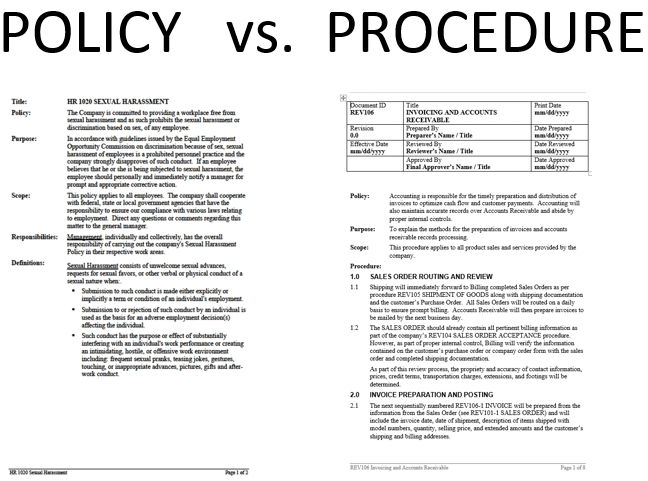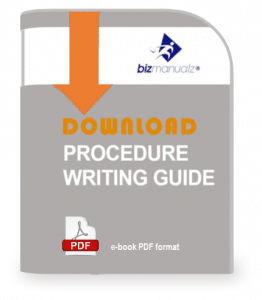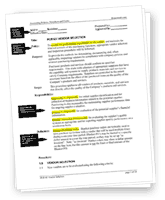How Do You Write Policies and Procedures?

Any old policy and procedure format saves time by not having to start from scratch, right? Well, not necessarily. Using a weak starting point can hurt employee usability, introduce confusion and user-error, and may not assist in your compliance and control objectives. The result could set your procedures project back further and cost you even more time to fix it later. So, why else should you write policies and procedures? When you write policies and procedures, keep in mind that they should be action oriented, grammatically correct, and written in a consistent style and format to encourage maximum usability. This will result in an increase in both effectiveness and efficiency.
How Do You Write a Policy?
Your policy expectations are derived from your community, management, and your own company culture. Must you arrive to work at a certain time? Dress a certain way? These business policies are part of your employee handbook. To find out what policy to write about you will need to research the expectations of your community and management.
What are Examples of Employee Policies?
Your government may expect that you follow the laws of the land. In the US we have laws to protect the environment (EPA), workers (OSHA), and the individual from discrimination (EEO) or unfair pay (FSLA) and a whole host of other laws (FDA, FMLA, ADA, etc). These expectations must be understood by every company that does business in the U.S. and deployed as company policy. Organizations typically use an employee handbook or posters in the lunch to communicate company policies.
What are Examples of Company Policies?
Writing policies like this are part of your Human Resources Policies and Procedures Manual. Small companies may only have an employee handbook that addresses some of these but in a larger organization (100+ employees) you should develop a more comprehensive HR Manual because a larger organization must adhere to all of the HR laws while a smaller company has many exemptions.
How Do You Write Procedures?
Your procedure expectations are derived from your process design. Most people start documenting their process first. This is a good first step to understanding your process. The next step is to document your process expectations into your procedure. What is the objective of this process? Are there expected quality levels, productivity rates or performance?
A well-defined process will clearly indicate the performance criteria necessary for consistent results. The goal of your procedures should be to ensure consistency so that anyone that performs the procedure will perform it the same way every time.
How Many Procedures Do You Need?
Once you realize why you need to write procedures, the next obvious question is what procedures do I need to write? Do I need to document all the processes in all departments with procedures?
Creating dozens and dozens of procedures is usually not necessary. In fact, such an approach can create more problems than it resolves. They can’t be found, they aren’t used, they aren’t updated, and a glut of uncontrolled copies are scattered throughout the organization (a non-compliance in many audits). If you are just starting a project to create or update procedures, selecting what procedures to write is an important early step.
Where do you start writing procedures? When starting this kind of document project, it is best to begin with one department that has mature processes. Create procedures for this department before expanding the project to other departments. If you are not skilled at writing, you can seek advice from specialized services that can help you write, edit, or grammar check your document. For example: EssaysAdvisor can assist you in choosing a conscientious and competent company.
What are the Benefits of Writing Policies and Procedures?
An effective policy procedure manual is easily understood by all of your employees in the organization. So how do you create an effective policies and procedures manual in the first place? Follow the link, we are talking about the benefits of writing policies and procedures…
Procedures Help Performance Improvement
It is the first step in performance improvement. If you want to improve, then you have to establish a baseline for improvement, so writing company policies and procedures makes a great start to performance improvement.
If your policies and procedures are already written, but they are incomplete, outdated or inconsistent, then you are probably not driving the performance improvement you intended. If you write company policies and procedures, you are one step closer to improving your business, which will lead you to saving money and helping increase customer satisfaction.
Policies and Procedures Eliminate Confusion
Written policies and procedures eliminates confusion, shortens training time, and saves time from employees having to find someone to ask questions.
Procedures Improve Results
To be confident you’re buying a procedure template that gets the job done quickly and correctly, it’s important to examine its basic elements. Take a moment to view the following features that you should be using, and also learn how to benefit with such crucial time-saving features as:
- An ISO 9001 compliant procedure format for easier readability
- A clear and concise header block to ensure a procedure communicates the purpose and scope
- Clear department responsibilities that identify who does what
- Key term definitions to reduce confusion
- Measures of effectiveness to quantify outcomes
- References to related documents to improve usability
- Listing of applicable laws or regulations to communicate compliance
- Detailed list of revisions to track edit history
- Forms to ensure proper control and record keeping
Writing Procedures Documents
Selecting what procedures to write for a department is very closely related to understanding why we write procedures. What are the compliance issues? What are the most important risks that need to be addressed? What processes require a high level of control, and where is improvement needed? Then prioritize in order of importance for all these areas: now you have selected what processes should be documented by procedures.
Process Documentation
The idea is to select and develop procedures in phases; by department and by degree of importance. Work within a department and develop procedure manuals or documents only for the processes that are identified as meeting our criteria for “why we write procedures.” In a first pass document development project for a small to medium size organization, we might typically developing 5 to 12 procedures for a department, depending, of course, on the size and complexity of the organization (as well as compliance issues).
Department Documentation
In the long run, starting slowly in a focused way can produce dividends, and make for a smoother, more efficient documentation project. Only focusing on top tier priority procedures within each department in the first pass phase allows the process owners and department members to integrate the procedures into their department documentation and operation. Then, when the documentation project returns to develop another tier of procedures, the department can assist in providing meaningful feedback on how useful and accurate existing procedures are, and assist in selecting what, if any, processes should be documented with procedures in the second pass phase.

Procedure Writing Templates Save Time
With more effective and efficient features, you can finish your policies and procedures project sooner. A core set of “best practices” policies and procedures templates will begin to save you time right away.
Even a simple map like this might be a huge improvement over your current procedure development process. Well, guess what? We don’t even get this much in all but a few isolated circumstances. (And to the lucky few who’ve gotten what they needed, please tell us what was it like.)
Like a castaway on the raft, it often seems as though we’ve been dropped into the middle of the sea without a sense of where we came from, where we’re going, or how we’re going to survive the journey, let alone get to our destination, wherever that might be. Too often, we start our journey somewhere in the middle (Procedure Template Design or Procedure Writing) instead of at the appropriate starting point (Project Management).
Download a Free Sample Procedure
To help you get started, we invite you to download a free policies and procedures MS-Word template. Use this procedure document as a guide to get started.

















HR directors are also expected to be excellent at communication. This is because as a part of their role, as well as defining processes and rules, they also need to communicate them to the rest of the workforce and to help management communicate their decisions throughout the organisation.
A policy contains a description of a rule or standard. Policies do not change often. Policies may not contain procedures or additional information.
Human resources experts, particularly in bigger sized organisations, are frequently involved in formulating and formalising company rules and processes. This is one of the reasons HR directors frequently attend strategy and planning meetings with the company’s top management team.
The common practice seems to be:
Find a published policy that’s close to what you want.
Modify that policy to better suit the needs of your company.
Honestly, I think every tech person hates writing these docs so the “embrace and extend” philosophy runs pretty deep.